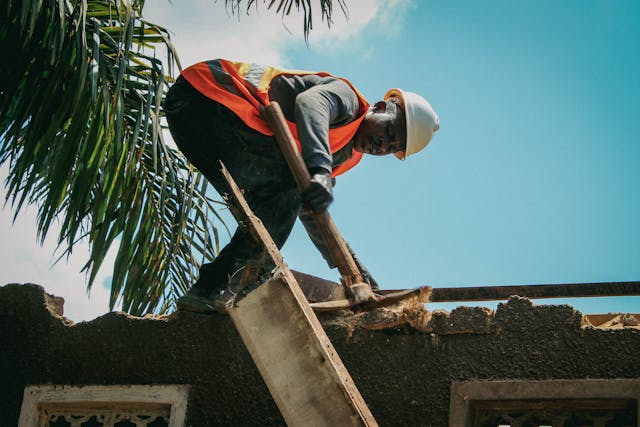There’s a leak. Or missing shingles. Or water stains on the ceiling. Something’s wrong with the roof, and now comes the question nobody wants to face: repair it or replace the whole thing?
Both options cost money. One is expensive now. The other might mean throwing money at a roof that needs replacing anyway. Making the wrong choice means wasting thousands of dollars.
Understanding what drives this decision helps homeowners avoid both unnecessary full replacements and inadequate repairs that just delay the inevitable.
The Age Factor
Roof age is the starting point for this decision. A roof that’s five years old with damage probably just needs repair. A roof that’s twenty-five years old with damage is probably telling you it’s done.
Most asphalt shingle roofs last 20 to 30 years depending on quality and conditions. Past the 15-year mark, repairs start becoming less sensible because other problems will follow soon. Below 10 years, repairs usually make more sense unless damage is extensive.
But age alone doesn’t decide it. A poorly installed 10-year-old roof might be in worse shape than a well-maintained 20-year-old one. Age provides context, not answers.
The Extent of Damage
Minor damage in one area suggests repair. Widespread problems across the entire roof suggest replacement. The challenge is knowing which situation actually exists.
A few damaged shingles from a fallen branch? That’s repair territory. Curling, cracking, or missing shingles across large sections? That’s the roof failing and replacement is probably needed.
Water damage is trickier. One leak might just be a repair issue. But if the decking underneath is rotted or damaged, the problem is bigger than it appears from the outside. This is where professional assessment becomes necessary because homeowners can’t see what’s happening under the shingles.
Working with experienced contractors like those providing roofing idaho falls services or equivalent professionals in other areas helps determine whether damage is isolated or systemic. They can see what’s happening with the underlying structure, not just surface problems.
The Multiple Repair Warning Sign
One repair is normal over a roof’s lifetime. Two or three repairs in a few years suggests the roof is declining overall. At some point, repair costs add up to where replacement would have been smarter.
If a roof needed $2,000 in repairs two years ago, another $1,500 last year, and now needs another $2,500, that’s $6,000 in repairs—probably more than half the cost of replacement. And the roof still has all its other aging shingles that will fail soon.
Tracking repair history helps make this decision. When repair costs start stacking up faster than expected, it’s usually time to consider replacement seriously.
The Energy and Insurance Considerations
Older roofs are less efficient. They don’t insulate as well. They make heating and cooling systems work harder. This shows up in utility bills but people often don’t connect it to the roof.
Insurance companies also care about roof age. Some won’t cover roofs past certain ages. Others charge higher premiums. A roof approaching 20 years might create insurance complications that make replacement more attractive than just the physical condition suggests.
These factors don’t always tip the decision alone, but they’re part of the total picture. A repair that keeps an aging roof limping along might cost more in energy waste and insurance hassles than the repair itself costs.
The Future Plans Factor
How long someone plans to stay in the house matters. Planning to sell in two years? A repair that keeps the roof functional might be enough. Planning to stay twenty years? Replacement probably makes more sense because the roof will need it eventually anyway.
For sellers, this gets complicated. A patched roof might work functionally but could hurt home value or complicate sales. Buyers notice old roofs and either demand price reductions or walk away. Sometimes replacement before selling pays back in easier sales and better prices.
The Hidden Damage Discovery
This is where things get expensive in ways people don’t expect. A roofer comes to repair what looks like minor damage and discovers the decking is rotted, rafters are damaged, or there’s extensive water damage underneath.
Now the “repair” turns into major work. The cost jumps from a few thousand to potentially tens of thousands. And at that point, replacing the whole roof while everything’s torn up often makes more sense than doing extensive structural repair but keeping the old shingles.
This scenario happens more often than homeowners expect. What starts as a repair estimate turns into a replacement recommendation once the contractor sees what’s really going on underneath.
The Quality Mismatch Problem
Repairing one section of roof with new shingles creates visual mismatches. New shingles don’t blend perfectly with aged ones. Different manufacturing lots have slightly different colors.
For front-facing damage, this matters to people who care about appearance. The repair works functionally but looks patchy. Replacing just the damaged area solves the immediate problem but creates an aesthetic issue.
Some homeowners accept this trade-off. Others can’t stand the mismatched look and end up replacing the whole roof for appearance reasons even when repair would work functionally.
The Weather Timing Challenge
Roof problems often show up after storms. That’s when homeowners discover damage and start making decisions. But after major storms, roofers are swamped. Good contractors are booked months out.
This creates pressure to make decisions quickly, often without full information. Emergency repairs might be necessary to prevent further water damage while deciding on long-term solutions. But temporary fixes cost money that could have gone toward permanent solutions.
The timing pressure doesn’t change what the roof needs, but it complicates the decision-making process when homeowners feel rushed.
The Money Reality
Repairs cost $500 to $3,000 typically. Full replacement costs $8,000 to $25,000 depending on size, materials, and complexity. The difference is significant enough that people naturally want to repair if possible.
But repairs on a failing roof just delay replacement while adding cost. That $2,000 repair on a roof that needs replacing in two years means spending $2,000 now plus the full replacement cost soon. The repair didn’t save money—it added to the total expense.
The hardest part is accepting that sometimes the only financially smart choice is the expensive one. A roof that genuinely needs replacement won’t be fixed by repairs, and trying just wastes money.
Making the Actual Decision
The repair versus replacement decision comes down to several factors working together. Age, damage extent, repair history, energy efficiency, insurance implications, future plans, and budget all play roles.
Getting professional assessment from multiple contractors helps. They can see structural issues homeowners can’t and provide realistic guidance about what makes sense. Beware of contractors who always push replacement when repair would work, but also don’t ignore advice that replacement is necessary just because it’s expensive.
Most importantly, don’t put off the decision hoping the problem resolves itself. Roof problems only get worse. Small issues become major ones. Cheap repairs become expensive replacements. Acting when problems are first discovered prevents them from expanding into something worse.
The roof replacement decision isn’t fun, but it’s necessary. Making it based on actual condition rather than wishful thinking about repairs saves money long-term and prevents the bigger headaches that come from letting roof problems go unaddressed.




